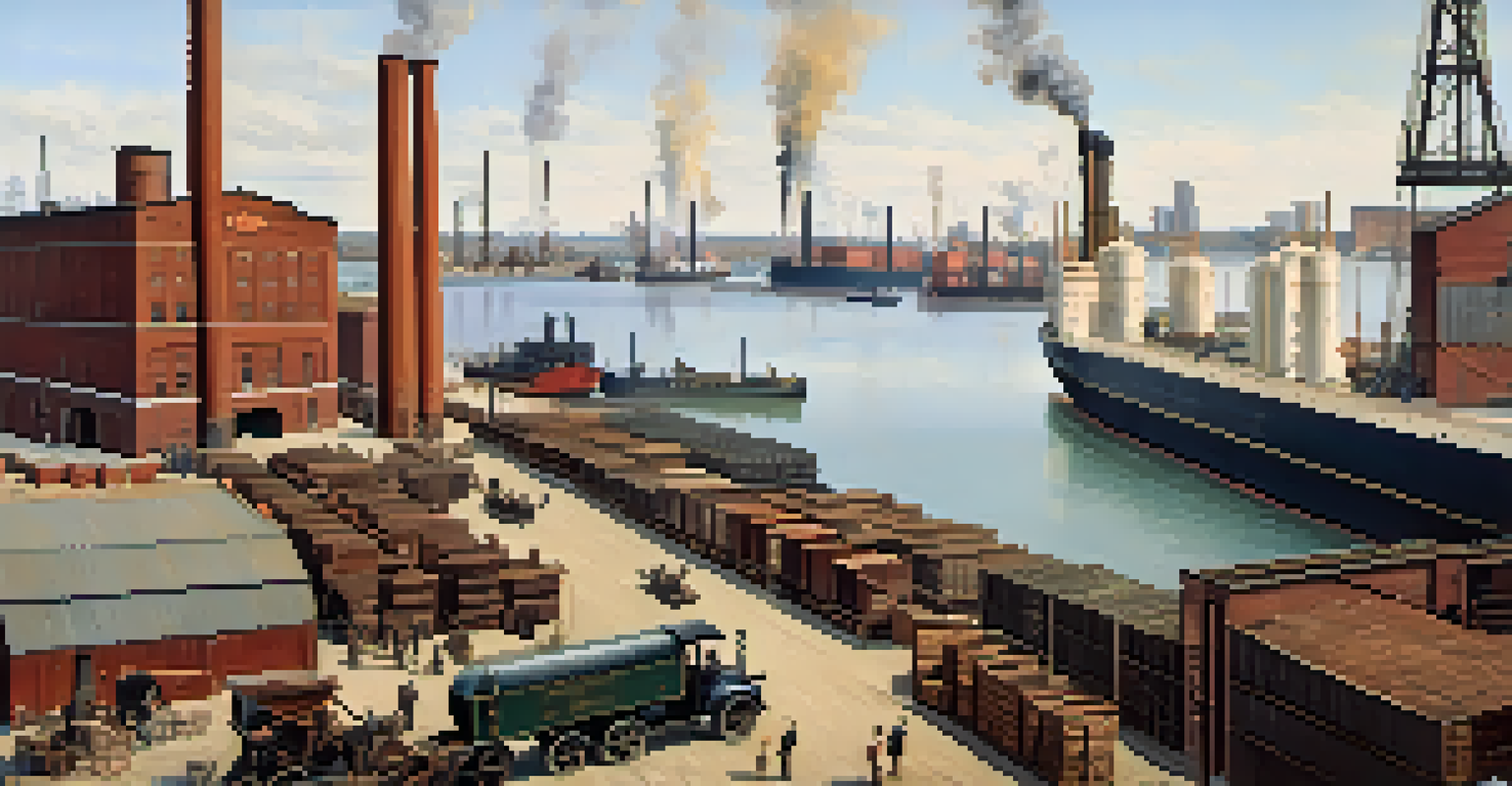The Role of the Great Lakes in Detroit's Historical Development

The Great Lakes: A Geographic Advantage for Detroit
Detroit's location near the Great Lakes has played a pivotal role in its development. Nestled at the river's edge, the city benefits from direct access to these vast freshwater bodies, which historically facilitated trade and transportation. This geographical advantage made it an ideal hub for shipping goods, connecting the Midwest to the rest of the country.
The Great Lakes are a living reminder of our past, a resource for our present, and a legacy for our future.
In the early days, the Great Lakes served as a major thoroughfare for settlers and traders, allowing for the easy movement of resources and people. Imagine the bustling scene of boats and ships laden with lumber and agricultural products, all navigating the waters to reach distant markets. This activity laid the groundwork for Detroit’s emergence as a key economic player.
As trade expanded, so did the city’s population and infrastructure. With the Great Lakes at its doorstep, Detroit evolved from a modest settlement into a vibrant metropolitan area. The interplay between geography and growth is a fascinating aspect of Detroit's historical narrative.
Industrial Growth Fueled by Lake Access
The industrial boom of the late 19th and early 20th centuries in Detroit was closely tied to its proximity to the Great Lakes. Factories and shipyards sprang up, taking advantage of both the water for transportation and the rich resources found in the region. This surge in industry transformed Detroit into the Motor City, as automobile manufacturing took center stage.

Waterways acted as vital arteries for the transportation of raw materials like iron and coal, essential for manufacturing. Picture the scene: massive freighters arriving at the docks, unloading their cargo to fuel the assembly lines of burgeoning car manufacturers. This ease of access not only boosted local production but also attracted a workforce eager for jobs.
Geographic Advantage of Detroit
Detroit's proximity to the Great Lakes has historically facilitated trade, transportation, and industrial growth.
The impact of the Great Lakes on Detroit’s industrial landscape cannot be overstated. They were more than just a resource; they were a lifeline that sustained economic prosperity and shaped the city's identity during a critical period of growth.
Cultural Exchange and Diversity from Immigration
Detroit's development was not just economic; it was also a melting pot of cultures, largely influenced by its connection to the Great Lakes. As the city thrived, it attracted waves of immigrants seeking opportunities in factories and shipping. These individuals brought diverse customs, languages, and traditions, enriching Detroit’s cultural fabric.
Water is the driving force of all nature.
Many immigrants arrived via the lakes, with journeys from Europe and beyond made simpler by the shipping routes. Imagine the stories of families arriving with dreams of a better life, stepping off ships and into the bustling streets of Detroit. This influx led to vibrant communities that contributed to the city’s unique identity.
The Great Lakes thus served as more than a trade route; they were a conduit for cultural exchange. The blend of influences from various backgrounds helped shape Detroit into a dynamic city, fostering innovation and creativity.
Recreation and Tourism: The Great Lakes’ Impact
Beyond trade and industry, the Great Lakes have also played a significant role in recreational activities and tourism in the Detroit area. From boating to fishing, the lakes provide a backdrop for countless leisure pursuits that enhance the quality of life for residents and visitors alike. This natural beauty attracts tourists, contributing to the local economy.
The stunning waterfront parks and beaches along the Great Lakes offer a respite from city life, drawing people to enjoy outdoor activities. Picture families picnicking by the shore or children splashing in the water, creating cherished memories. These recreational opportunities foster a connection between the community and the natural environment.
Cultural Diversity from Immigration
The Great Lakes served as a key route for immigrants, enriching Detroit's cultural landscape with diverse traditions and communities.
As a result, the lakes are not just a historical asset; they continue to influence Detroit’s present and future. They serve as a reminder of the city’s rich history while offering a canvas for recreation and relaxation.
Environmental Challenges: A Historical Perspective
With the growth of Detroit and the surrounding region, the Great Lakes have faced significant environmental challenges over the years. Industrial expansion brought pollution and habitat destruction, impacting water quality and wildlife. Understanding this history is crucial for recognizing the importance of conservation efforts today.
The effects of pollution in the lakes have been profound, sparking movements for environmental protection. Residents have witnessed firsthand the decline in fish populations and the health of the waterways. This history underscores the need for sustainable practices that honor the lakes as vital resources.
Detroit’s journey with the Great Lakes serves as a cautionary tale about the balance between progress and preservation. By learning from past mistakes, the city can work towards a more sustainable future that respects the natural environment.
The Great Lakes as a Source of Identity for Detroit
The Great Lakes have become an integral part of Detroit’s identity, symbolizing both challenges and triumphs. The lakes are not just a geographical feature; they represent the spirit of resilience and adaptability that defines the city. This connection fosters a sense of pride among residents who cherish their local environment.
Many cultural events and festivals celebrate the Great Lakes, highlighting their importance in the community. From art installations to boat races, these activities reinforce the bond between the city and the water. Imagine the excitement of a summer festival where the waterfront comes alive with music, food, and laughter.
Environmental Challenges Ahead
Industrial growth has led to environmental issues in the Great Lakes, highlighting the need for sustainable practices and conservation.
In this way, the Great Lakes serve as a unifying force for Detroiters, instilling a shared sense of purpose and community. They are a reminder of the city’s rich history and a beacon for future generations to protect and cherish.
Future Prospects: The Great Lakes and Detroit
Looking ahead, the Great Lakes will continue to influence Detroit's trajectory in various ways. As the city embraces sustainability and innovative practices, there's potential for a renewed focus on preserving the lakes for both economic and ecological benefits. This forward-thinking approach can create opportunities for green jobs and sustainable tourism.
Moreover, investments in waterfront development and infrastructure can enhance access to the lakes, making them more integral to daily life. Imagine a revitalized waterfront where residents can live, work, and play, all while enjoying the beauty of the Great Lakes. Such developments can foster community engagement and economic growth.

Ultimately, the future of Detroit and the Great Lakes is intertwined. By recognizing their historical significance, the city can pave the way for a brighter, more sustainable future that honors its past while looking forward.